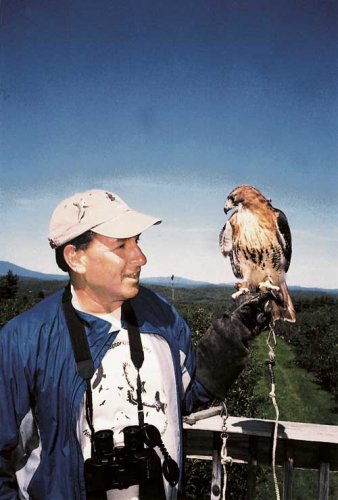A rehabilitated red-tailed hawk was released back into the wild by the New Hampshire Audubon Society President Michael Bartlett on Sept. 20, at the society’s raptor observation platform on the grounds of the Carter Hill Orchards.
This past spring Simon Huntington found the hawk in Manchester, where it may have fallen from its nest before it had learned to fly. In May it was taken to the Wings of the Dawn Bird Sanctuary in Henniker where Maria Colby, director, prepared it to live in the wild.
Colby was present to take the hawk from its travel cage and hand it over to Bartlett who released the hawk to the cheers of about a hundred people who came to witness the event. The hawk soared over the crowd and flew across the orchard, a free bird at last.
Prior to the release of the hawk, Robert Vallieres, a volunteer naturalist with the New Hampshire Audubon Society, was present with another red-tailed hawk to describe the hawk’s characteristics. He said the hawk he was holding had a broken wing after being hit by a car and could not be returned to the wild. He is now using the bird in demonstrations for educational purposes.
With a robust body and broad wings, the red-tailed hawks are the most widely distributed hawks in the Americas. During the migration season, hawks are leaving their summer quarters. “In the last three days spotters have seen over 800 hawks fly within sight of this observation tower,” Vallieres said.
The red-tails are great hunters and are often used for falconry in the United States. They are opportunist feeders, with rodents making up 85 percent of their diet. They have needle-sharp talons for grasping their prey.
The word “raptor” is from the Latin, “rapare,” meaning to grasp.
The flight of red-tails involves slow and deliberate deep wing beats, and they like to soar upward on the thermals, circling higher and higher, and then hunt as they descend. Their eyesight is phenomenal. It is said they can spot a mouse a half mile away.
Red-tailed hawks are legally protected in Canada, Mexico and the United States by the Migratory Bird Treaty Act.
Vallieres asked if anyone in the crowd would like to imitate the cry of a red-tailed hawk. No one responded. My bird books note that the call of a red-tailed hawk is a rasping scream that sounds like a steam whistle or the squeal of a pig. That explains why no one responded.
Now the red-tailed hawk that was released has the freedom to scream over the tree tops.









